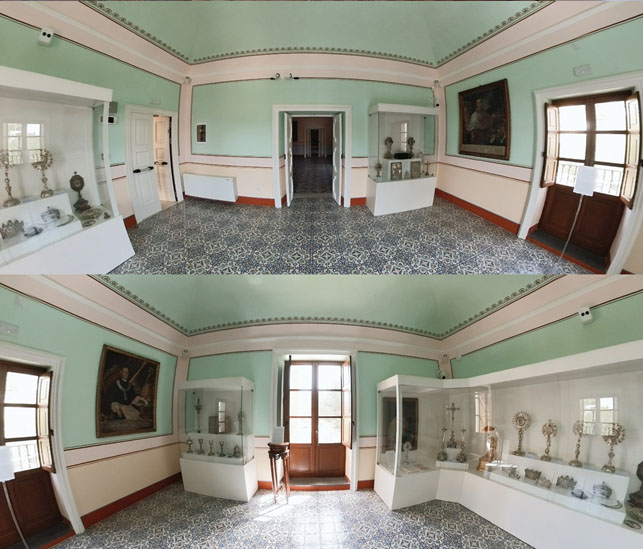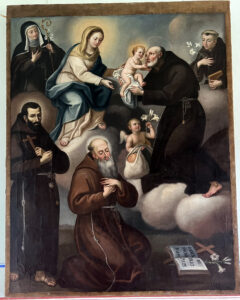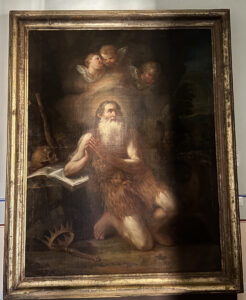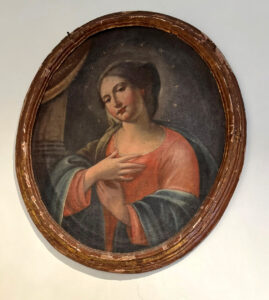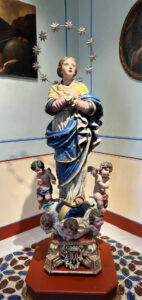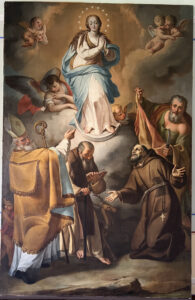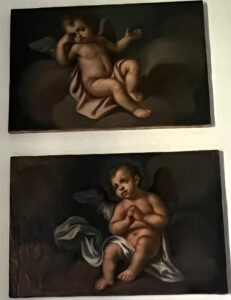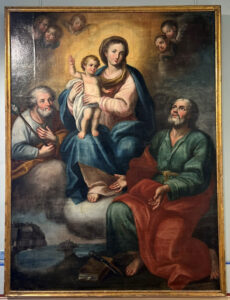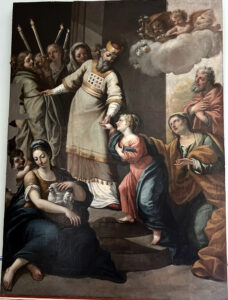Room IV
Room IV is dedicated to Monsignor Vincenzo M. De Francisco, a Dominican of Palermo origin, bishop of Lipari from 1753 to 1769. On display are some valuable silver artefacts, mostly from Lipari Cathedral.
After the terrible sack of 1544, there was a significant population increase and urban development in Lipari that continued, significantly, over the next two centuries. The climate of particular religious fervour, fuelled by the Council of Trent, also led to the construction of new churches together with the restoration and embellishment of existing ones. This trend culminated in the 18th century thanks to a few bishops: all Sicilian prelates who, besides being zealous pastors, showed that they cared about the material and social well-being of their faithful.
Thus, in this period of time, from the single ruined chalice recorded at the end of the 16th century, we move on to an increasingly rich inventory of sacred vestments and vessels, commissioned from the finest workshops in Messina and Palermo.
Particularly munificent was Bishop De Francisco, who donated various furnishings and sacred vessels to the Cathedral during his rule, as well as valuable vestments and bindings for liturgical books. He also granted considerable benefits to the Chapter of Canons who, as a sign of gratitude, erected a bust-portrait for him in the Chapel of the Rosary of Lipari Cathedral, where his remains also rest.
Room 4 therefore houses a number of portraits of bishops, including Mgr. De Francisco himself, Mgr. Coppola and Mgr. Di Miceli, and three display cases containing precious silver artefacts: monstrances, reliquaries and other liturgical objects, including a series of interesting crowns once used to embellish paintings of the Virgin and Saints. The various artefacts are almost all stamped with the hallmarks of famous silver workshops, especially from Messina and Palermo, from the 17th and 18th centuries, or bear monograms and coats of arms of the commissioning bishops.
Among the documents from the historical archives of the Diocese of Lipari is the will of Bishop Di Miceli and the list of goods in the bishop’s palace at the time of his death in 1753.
THE RELICS
The various bishops of Lipari also paid particular attention to checking the relics kept in Lipari Cathedral, for which detailed lists were drawn up as part of pastoral visits.
Already Mgr. Alfonso Vidal, in the 1602 Visit, notes that the Cathedral keeps some famous relics in an ark covered with a red silk cloth, closed with four keys. These include the milk of the Virgin Mary in a ‘crystal carrafella’, the thumb of St. Bartholomew the Apostle, a piece of bone of St. Philip the Apostle, a piece of bone of St. Gregory the Great, a bone cinnamon of St. Mark, a rib of St. Catherine the Martyr and other relics.
On the feasts of the respective saints, these relics – later arranged in gilded busts – were also carried in procession. Bishop Agostino Candido in 1651 records in particular that: “in the month of February, on the 13th, a solemn procession takes place in which the sacred relic of St Bartholomew is carried out of the city, proceeding to the place where the temple dedicated to the same Apostle, in which his sacred body was kept, was built in ancient times. The same relic was carried in procession on 17th June and 24th August’.
Among the particularly precious relics are some fragments of the Cross of Christ, kept in a reliquary, with an architectural structure inspired by a late florid Gothic style, which is still carried in procession on Good Friday, together with the ‘varette’ representing some scenes of the Lord’s Passion. In his pastoral visit, Archbishop De Francisco records the presence of such a reliquary in the cabinet kept in the Chapel of the Most Holy Crucifix in Lipari Cathedral: ‘From the wood of the Holy Cross of our Lord Jesus Christ six fragments are included in a gilded silver cross placed in a well-made monstrance with a silver foot similarly decorated at the apex of which there is a cross with the image of the Crucifix of the same material as the whole monstrance. On the sides are images of the Holy Apostles Peter and Paul’.
The first showcase contains:
various monstrances, adorned with semi-precious stones and elegant cast figures, a 17th century outfit consisting of an altar cross and two candlesticks, a wooden trunk, a series of silver crowns once placed directly on the paintings.
In the second showcase:
a number of chalices, the oldest monstrance found, a thurible, a coprimessal with the martyrdom of St Bartholomew and St Agatho, the capitular mace.
In the third showcase
a precious reliquary of the Holy Cross, a reliquary-hostorium, a peace, two wooden reliquaries, a wooden and mother-of-pearl cross.
On the walls are portraits by unknown 18th century artists of the bishops:
Francesco Maria De Miceli, Vincenzo Maria De Francisco and Giuseppe Coppola..

